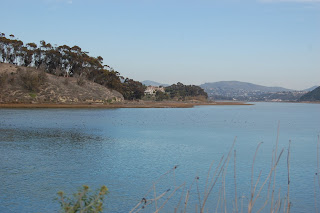There is 1.5 mile trail along the north side of the lagoon. There are 180 species of birds that have been observed there. This is the 2nd time we've been there. But the first time since we began bird watching.
Here are some of the interesting ones we saw.
American White Pelican: We've seen California Brown pelicans a lot but this is the first time we saw white pelicans. The California brown pelican is the only pelican that plunge-dives. The white pelican hunts by scooping fish from the water while swimming.
Killdeer: Killdeer is a midium size plover with black and white double breastbands. We've been always wondering about their werid name. Their name is actually from the sound they make is like 'deedeedeedee,kill-deeear'. Below are the photos we took. See the black and white breastbands?
There are two types of white egrets you often can see. One is Great Egret, the other one is Snowy Egret. Sizewise Great Egret is much bigger than the Snowy Egret. It's about 38 inches tall! But sometimes from far away it's hard to tell the size. Easy way is, if it's yellow-billed and black feet, it's Great Egret. If it's black-billed and yellow feet, it's Snowy Egret.
Willet is a pretty large shorebird with straight long bill which is different from Long-billed Curlew who has a downturned bill. When they fly, their underwing pattern is bold black and white. It's very similar looking as Greater Yellowlegs. The main difference is the leg color. Willet has gray legs and of course, Yellowlegs have yellow legs.
Below is a picture with the Great Egret and Willet together.
We also noticed a white/gray hawk. It was flying above the lagoon with very white belly and black wing tip. And then we identified it was a Osprey. Osprey are year-round in Baja Mexico and Florida. It's not common in San Diego but occasionally you can spot them when they are on their migration route. We watched it dive down and snatch a big fish from the water. It struggled and was barely able to lift the fish. And it finally brought the fish to the shore to eat. This was the 2nd exciting experience for that day.
Later we were walking on the trail to the east side of the lagoon and we noticed a big black hawk-looking bird on the top of a very tall tree. When we got closer and we realized it was too big to be a hawk. So we looked through our field guide to figure out what it was.
That was a Golden Eagle! The whole body was brown/black without any white spots. Its length is 34inches with wing span can be 84 inches!
We often see Eucalyptus trees in Southern California. Those trees normally are very very tall with slender trunks. We always think they are pretty, fast-growing and can be kaola bears' foods. But today we learn they are actually native to Australia and invading native plant habitats! The leaves and seed pods that fall beneath the trees contain pungent oils that prevent other plants from growing underneath.
Below are some flowers pictures. California Holly and California Buckweed. California Holly gives the name for city of 'Hollywood'.
We also observed Northern Pintails, American Wigeon, Snowy Egret, many Hummingbirds, Cassin's Kingbird, California Gnatcatcher...














No comments:
Post a Comment